Are you a Quiet Speculation member?
If not, now is a perfect time to join up! Our powerful tools, breaking-news analysis, and exclusive Discord channel will make sure you stay up to date and ahead of the curve.
In the absence of data, speculation and rumor thrive. It's time to correct that problem with a deep data dive. I have been collecting metagame data for the past month, and today I'm going to share my findings. The rhetoric about companions has been flying thick since they were revealed, but their actual impact was hard to measure. My data was collected and analyzed with an eye towards determining the impact of companions on Modern. The data is pretty clear on this point, but also brings up more questions to investigate.
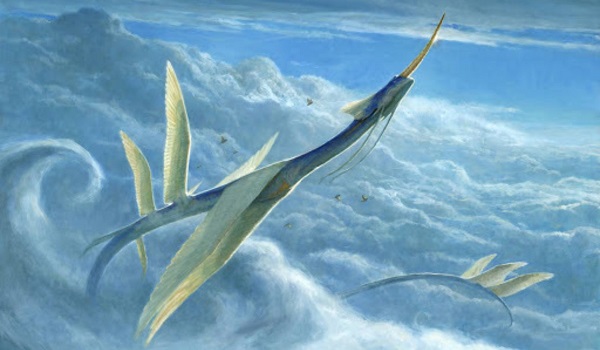
Methodology
To build this data set, I've been collecting every MTGO result that's posted to the official MTGO decklist page since April 20. I picked that day as the starting point because of card availability. While the MTGO release date was April 16, it was in short supply for constructed purposes. This is understandable and typical, because the online sellers have to get their cards the same way everyone else does, unlike real stores that can load up on stock prior to release. All of the new cards weren't consistently available from the big bots until the 20th, so it's reasonable to assume that prior to that day many players that would have used the new cards couldn't, yielding spotty representation. The data would have therefore been unreliable.
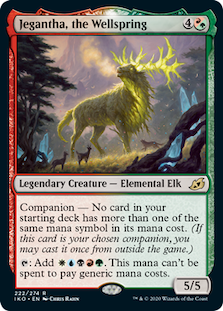 I then recorded every deck in every listed premier Modern event. This was not only the challenges, Super Qualifiers, and PTQs, but also the preliminaries. Prelims are actual tournaments, unlike Leagues, and so provide more reliable data. I recorded not only the deck, but which, if any, companion it was running.
I then recorded every deck in every listed premier Modern event. This was not only the challenges, Super Qualifiers, and PTQs, but also the preliminaries. Prelims are actual tournaments, unlike Leagues, and so provide more reliable data. I recorded not only the deck, but which, if any, companion it was running.
I then recorded the same data for the pre-Ikoria metagame, running from March 23 to April 11. The overall timeframe needed to be the same as with the Ikoria metagame so as to compare like-to-like as best as possible. I also wanted to avoid including release week because again, I wasn't sure when the new cards would actually become available, and release week is always a weird time for constructed. Some decks always seem to be overrepresented, and I wanted to avoid any weirdness skewing the data.
Curating the Data
Once I had the data, it was clear that some curation would be necessary. The first problem was scale. The Ikoria metagame included ~77 different decks (It depends on how the line is drawn). The pre-Ikoria metagame had 69. That's too many individual decks to deal with, and the sheer number of rogue decks skewed the data. The first thing I did was combine decks that shared a strategic archetype and play pattern. In practice, this meant I lumped all the creature combo decks together as Toolbox. On a macro level, they're all creature decks that rely on tutors to function and combos to win with creature beatdown as a backup. Similarly, I lumped in Stoneblade decks with their pure control equivalents.
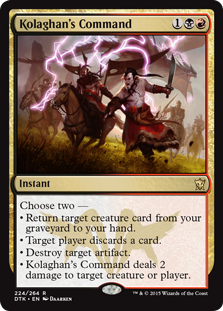 Jund and The Rock are together under BGx. They're essentially the same attrition deck, with the only real distinction being Lightning Bolt and Kolaghan's Command. Sultai decks were listed separately, as the addition of blue significantly changes how the deck plays. For the same reason, both straightforward GR Valakut and the Amulet-less Titan decks are together under Gx Valakut. Not every Valakut deck has red, and the Amulet-less decks play more similarly to Valakut decks than to Amulet Titan.
Jund and The Rock are together under BGx. They're essentially the same attrition deck, with the only real distinction being Lightning Bolt and Kolaghan's Command. Sultai decks were listed separately, as the addition of blue significantly changes how the deck plays. For the same reason, both straightforward GR Valakut and the Amulet-less Titan decks are together under Gx Valakut. Not every Valakut deck has red, and the Amulet-less decks play more similarly to Valakut decks than to Amulet Titan.
The list was further narrowed when I lumped the lowest-population decks together under Other. I chose five entries as my lower limit; anything with fewer than five decks in the data was an Other. The choice was arbitrary, as any such cut is going to be. Five just seemed like the place. This pared the data down to a more manageable 32 decks pre-Ikoria. I used those 32 decks as the basis for my comparison between the two eras. I needed to evaluate similar as possible data sets, so I needed to pick one set to be my baseline. I'm evaluating the impact that the companions have had, so comparing the new to the old makes the most sense.
The Pre-Ikoria Metagame
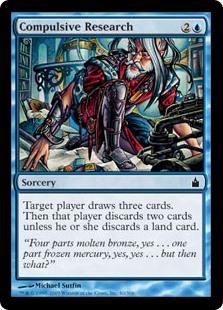 I should also note that I recorded only those events that had been posted as of 11:59 PM on 5/9. The cut off was because I needed to write this article. Subsequently, not every event that actually happened is present in the data. I know with certainty that one Super Qualifier from the third week is missing, and I'd wager there are several other missing events. As every event had an equal chance of not being posted by Wizards in my sampled timeframe, the data is still valid.
I should also note that I recorded only those events that had been posted as of 11:59 PM on 5/9. The cut off was because I needed to write this article. Subsequently, not every event that actually happened is present in the data. I know with certainty that one Super Qualifier from the third week is missing, and I'd wager there are several other missing events. As every event had an equal chance of not being posted by Wizards in my sampled timeframe, the data is still valid.
811 decks were posted in the Pre-Ikoria timeframe. Some of this may be that all of the events had finally been posted, some of it is definitely several very large preliminaries. This data represents the early part of the pandemic lockdown, and I imagine MTGO was the only thing for many players to do.
| Deck Name | Total # | % of Total |
|---|---|---|
| GR Ponza | 85 | 10.48 |
| Bant Snow | 68 | 8.38 |
| Other | 67 | 8.26 |
| Burn | 63 | 7.77 |
| Temur Urza | 54 | 6.66 |
| GBx Midrange | 49 | 6.04 |
| Dredge | 42 | 5.18 |
| Humans | 38 | 4.69 |
| Mono-Green Tron | 38 | 4.69 |
| Eldrazi Tron | 37 | 4.56 |
| Amulet Titan | 37 | 4.56 |
| Prowess | 30 | 3.70 |
| Niv to Light | 24 | 2.96 |
| Gx Valakut | 23 | 2.84 |
| Infect | 22 | 2.71 |
| Zoo | 17 | 2.10 |
| Whirza | 17 | 2.10 |
| Storm | 10 | 1.23 |
| Jund Death's Shadow | 10 | 1.23 |
| Toolbox | 8 | 0.99 |
| Ad Nauseam | 8 | 0.99 |
| Neoform | 8 | 0.99 |
| Eldrazi and Taxes | 7 | 0.86 |
| 4C Snow | 6 | 0.74 |
| Copycat | 6 | 0.74 |
| Silvers | 6 | .74 |
| Mardu Midrange | 6 | 0.74 |
| As Foretold | 5 | 0.62 |
| UW Control | 5 | 0.62 |
| Bogles | 5 | 0.62 |
| Underworld Breach | 5 | 0.62 |
| Temur Snow | 5 | 0.62 |
The first thing I want to note is that Bant Snow was not the best deck in the old metagame. That honor goes to GR Ponza, and it isn't close. I was always skeptical of Bant Snow, so it's nice to be vindicated. Why Ponza is best isn't clear. Some of that is likely cost. It's very cheap online to make that deck, and I imagine that many paper players like me didn't want to spend money on MTGO. Another may be positioning. Ponza is a turbo Blood Moon deck, unlike the land destruction of old. Moon effects were particularly devastating due to all the 3+ color manabases. Many were snow decks and had many basics, but they were reliant on fetchlands to make it work. Accelerating out a Moon before it all came together is devastating.
The second thing is that this metagame was strategically diverse. It's a bit tilted toward midrange decks, but aggro and ramp are still present.
Current Metagame
As of my cutoff, 479 decks from the Ikoria metagame had been posted. Again, I know some events are missing to explain the different sample size n values. Also, there were no monster prelims pushing up the numbers.
| Deck Name | Total # | % of Total |
|---|---|---|
| Other | 83 | 17.33 |
| Burn | 52 | 10.86 |
| GBx Midrange | 46 | 9.60 |
| Toolbox | 38 | 7.93 |
| Prowess | 29 | 6.05 |
| Amulet Titan | 27 | 5.64 |
| Bant Snow | 24 | 5.01 |
| Temur Urza | 23 | 4.80 |
| Humans | 20 | 4.18 |
| GR Ponza | 19 | 3.97 |
| 4C Snow | 15 | 3.13 |
| Ad Nauseam | 14 | 2.92 |
| Gx Valakut | 11 | 2.30 |
| Eldrazi Tron | 10 | 2.09 |
| Infect | 10 | 2.09 |
| Neoform | 9 | 1.88 |
| Mono Green Tron | 8 | 1.67 |
| Niv to Light | 8 | 1.67 |
| Dredge | 6 | 1.25 |
| Bogles | 5 | 1.04 |
| UW Control | 4 | 0.83 |
| Storm | 3 | 0.63 |
| Eldrazi and Taxes | 3 | 0.63 |
| Copycat | 2 | 0.42 |
| As Foretold | 2 | 0.42 |
| Jund Death's Shadow | 2 | 0.42 |
| Underworld Breach | 2 | 0.42 |
| Temur Snow | 2 | 0.42 |
| Zoo | 1 | 0.21 |
| Whirza | 1 | 0.21 |
| Silvers | 0 | 0 |
| Mardu Midrange | 0 | 0 |
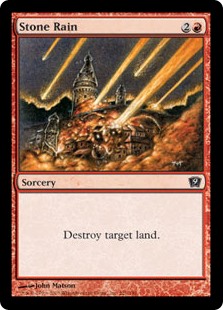 The mighty have fallen! Ponza and Bant Snow have been firmly kicked from the top slots. Now, Burn and BGx are king. It is worth noting that both are companion-heavy decks. All the Jund lists and nearly all the Rock decks ran Lurrus of the Dream-Den. Nearly all the Burn decks also had Lurrus. No deck archetype in this data that had companions did so universally. Every Hardened Scales list did have Lurrus, but since there were no Scales lists at all pre-Ikoria, I'm not considering them for analysis (yet).
The mighty have fallen! Ponza and Bant Snow have been firmly kicked from the top slots. Now, Burn and BGx are king. It is worth noting that both are companion-heavy decks. All the Jund lists and nearly all the Rock decks ran Lurrus of the Dream-Den. Nearly all the Burn decks also had Lurrus. No deck archetype in this data that had companions did so universally. Every Hardened Scales list did have Lurrus, but since there were no Scales lists at all pre-Ikoria, I'm not considering them for analysis (yet).
Worth noting that strategic diversity has increased from pre-Ikoria looking at the Other category. I will attest that the number of off-the-wall rogue decks was much higher in the new meta, meaning more singleton results. There were also a higher number of decks that didn't quite make the cut-off. Modern's diversity is still strong, even in a companion-heavy world.
In Comparison
The metagame has definitely shifted. Dredge was a major player in the old metagame and is just gone now. To quantify that change, here's how the samples metagame shares have changed.
| Deck Name | Pre-Ikoria % | Post-Ikoria % | Change in % |
|---|---|---|---|
| GR Ponza | 10.48 | 3.97 | -6.51 |
| Bant Snow | 8.38 | 5.01 | -3.37 |
| Other | 8.26 | 17.33 | +9.07 |
| Burn | 7.77 | 10.86 | +3.09 |
| Temur Urza | 6.66 | 4.80 | -1.86 |
| GBx Midrange | 6.04 | 9.60 | +3.56 |
| Dredge | 5.18 | 1.25 | -3.93 |
| Humans | 4.69 | 4.18 | -0.51 |
| Mono-Green Tron | 4.69 | 1.67 | -3.02 |
| Eldrazi Tron | 4.56 | 2.09 | -2.47 |
| Amulet Titan | 4.56 | 5.64 | +1.08 |
| Prowess | 3.70 | 6.05 | +2.35 |
| Niv to Light | 2.96 | 1.67 | -1.29 |
| Gx Valakut | 2.84 | 2.30 | -0.54 |
| Infect | 2.71 | 2.09 | -0.62 |
| Zoo | 2.10 | 0.21 | -1.89 |
| Whirza | 2.10 | 0.21 | -1.89 |
| Storm | 1.23 | 0.63 | -0.60 |
| Jund Death's Shadow | 1.23 | 0.41 | -0.82 |
| Toolbox | 0.99 | 7.93 | +6.94 |
| Ad Nauseam | 0.99 | 2.92 | +1.93 |
| Neoform | 0.99 | 1.88 | +0.89 |
| Eldrazi and Taxes | 0.86 | 0.63 | -0.23 |
| 4C Snow | 0.74 | 3.13 | +2.39 |
| Copycat | 0.74 | 0.42 | -0.32 |
| Slivers | 0.74 | 0 | -0.74 |
| Mardu Midrange | 0.74 | 0 | -0.74 |
| As Foretold | 0.62 | 0.42 | -0.20 |
| UW Control | 0.62 | 0.83 | +0.21 |
| Bogles | 0.62 | 1.04 | +0.42 |
| Underworld Breach | 0.62 | 0.42 | -0.20 |
| Temur Snow | 0.62 | 0.42 | -0.20 |
Ponza has fallen precipitously, mirrored by Toolbox's rise. The old midrange decks are all suffering to make room for Lurrus decks. It is significant that with the exception of Dredge, all the old good decks are still decent choices in the new metagame. This set doesn't show it, but Ponza was actually making a comeback during the week of 5/3.
The Companions
And now it's the data that everyone's actually here for: the companion data. While recording data, I noted every companion that was being played as a companion. I make this distinction because a few decks had maindeck Lurrus. The companions are far from universal, but they are endemic now.
| Companion | Total # | % of Total Population |
|---|---|---|
| Lurrus | 214 | 44.68 |
| Yorion | 57 | 11.90 |
| Obosh | 17 | 3.55 |
| Jegantha | 17 | 3.55 |
| Zirda | 7 | 1.46 |
| Umori | 2 | 0.41 |
| Gyruda | 2 | 0.41 |
| Lutri | 1 | 0.21 |
| Total | 317 | 66.17 |
First things first: No, your eyes do not deceive; someone did manage to place using a Lutri, the Spellchaser singleton deck. I don't know how, but it happened. I'm going to assume that's attributable to favorable variance and confused opponents. The deck looked like an Izzet Commander deck, so let no one ever say that the companions didn't do what Wizards wanted them to do.
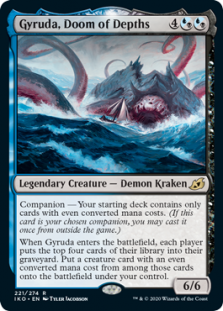 The Umori, the Collector decks were both mono-creature decks, which makes perfect sense. One was a Toolbox deck and the other was Elves. The Elves deck was unremarkable except for the companion, while the Toolbox deck was an odd mishmash of creature combo decks and GW Hatebears. They were in separate weeks, so I'm chalking them up to luck. Similarly, the Gyruda, Doom of Depths combo decks came from the same event. I wouldn't read too much into them; anything can place once.
The Umori, the Collector decks were both mono-creature decks, which makes perfect sense. One was a Toolbox deck and the other was Elves. The Elves deck was unremarkable except for the companion, while the Toolbox deck was an odd mishmash of creature combo decks and GW Hatebears. They were in separate weeks, so I'm chalking them up to luck. Similarly, the Gyruda, Doom of Depths combo decks came from the same event. I wouldn't read too much into them; anything can place once.
Zirda, the Dawnwalker was exclusively played in Toolbox decks, but only occasionally. As I noted in my companion article, it's surprisingly hard to eliminate all the combos that don't use triggered abilities. While it worked, the fact that Zirda only appeared in ~45% of Toolbox decks is telling. Similarly, Obosh, the Preypiercer was only played in Ponza decks. The only notable card that was cut from the older lists was Chandra, Torch of Defiance, so I'm guessing that this is a case of "why not?" more than of Obosh being actively good.
The Big Question
More importantly, decks running companions account for two-thirds of the total decks in the sample. No bones about it: they are saturating Modern. This level of saturation by an individual card is very similar to what happened with Oko, Thief of Crowns and Once Upon a Time. However, the effect is different. Once and Oko were warping the colors of the format 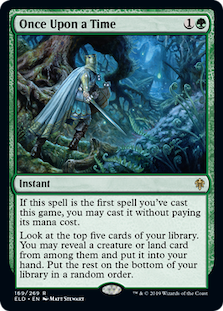 towards green and blurring the distinction between decks while companion decks still have distinct identities. Oko pushed decks towards being UGx artifact decks. Once got the otherwise colorless Eldrazi Tron to splash green.
towards green and blurring the distinction between decks while companion decks still have distinct identities. Oko pushed decks towards being UGx artifact decks. Once got the otherwise colorless Eldrazi Tron to splash green.
While companions, particularly Yorion and Lurrus, are pushing decks in similar directions, the impact isn't homogenizing archetypes. Yes, a lot of Lurrus decks are running a set of Mishra's Bauble. However, this is only a homogenizing force in the same way that many decks running Lightning Bolt is. Jund, Burn, and Toolbox decks are all still distinct. Compare this to the blurred lines between Bant Snowblade and the various flavors of Urza Oko decks. There's no evidence of harm to overall metagame diversity. The post-Ikoria Other category was largest by far and rivaled pre-Ikoria Ponza for raw numbers. Thus, the banning discussion shouldn't focus on harm to strategic diversity. This is a question of format saturation and power level.
The Dilemma
And those metrics are not clear-cut. The problem is that there's no way to determine if the companions metagame share reflects correlation or causation. Burn and BGx have risen to the top, but they were already very strong decks. Their ascension coincides, and thus correlates, with adoption of Lurrus of the Dream-Den. Lurrus clearly did not cause them to become good decks. There's no way with this data to determine if Lurrus made them the best decks in the metagame. It might be that Burn and BGx are just taking advantage of the fall of Bant Snow and Ponza, and that development may be unrelated to the companions. It's equally possible that companions gave Burn and BGx the power boost they needed to claim the throne. There's no clear answer.
Argument: It's Causal
One argument that there is a causal relationship is made by Toolbox. Before the companions, the collective compendium of creature combos and tutors was a complete non-factor in the metagame. Despite getting a new toy in the form of Heliod, Sun-Crowned, Toolbox just wasn't getting any traction. The archetype could only muster eight results across multiple decks, accounting for only ~1% of the metagame. Previously, this may have been dismissed as "Toolbox can't be played online due to lack of shortcuts and timing out." However, with online being the only venue to play Magic right now, players are forced to make it work.
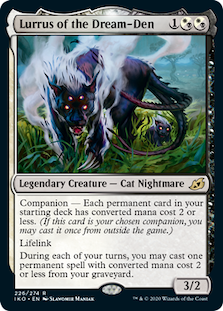 And clearly they have, as with the companions, Toolbox surged to being the third-best deck with an ~8% metagame share. The vast majority did have a companion, usually Lurrus. Jegantha, Umori, and Zirda were all options. The decks running Lurrus were as evenly distributed as the Zirda ones, which suggests one isn't better than the other in this context. As Toolbox wasn't a deck before companions but became one afterward, and the boost isn't tied to a single companion, the boost could have been the inherent power of the companions themselves. Thus, the companions are boosting decks that have them over decks that don't, and the relationship is causal.
And clearly they have, as with the companions, Toolbox surged to being the third-best deck with an ~8% metagame share. The vast majority did have a companion, usually Lurrus. Jegantha, Umori, and Zirda were all options. The decks running Lurrus were as evenly distributed as the Zirda ones, which suggests one isn't better than the other in this context. As Toolbox wasn't a deck before companions but became one afterward, and the boost isn't tied to a single companion, the boost could have been the inherent power of the companions themselves. Thus, the companions are boosting decks that have them over decks that don't, and the relationship is causal.
As further proof, look at Prowess. The deck had fallen off significantly from the start of the year and was only 3.7% of the metagame. After adopting Lurrus, it has surged to fourth place and 6.05%, almost double its previous level., Having a companion is strictly better than not.
Argument: It's Casual
Humans was in eighth place pre-Ikoria. Humans is in eighth place post-Ikoria. There is a negligible difference between their metagame shares, indicating that Humans has neither gained nor lost viability in this metagame. The only companion Humans can run is Jegantha, and it does so less than half the time. When Humans does run Jegantha, it doesn't do measurably better than otherwise. The only reason Humans is running Jegantha is for the 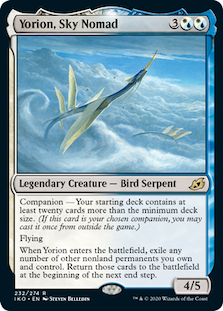 power boost of having a 5/5 "in hand" at all times, but at this time, there is no indication that this benefit translates to more wins. Similarly, Amulet Titan does not play companions at all, and has moved from eleventh place with 4.56% to fifth with 5.64%. It doesn't take a companion to win, it takes a good deck.
power boost of having a 5/5 "in hand" at all times, but at this time, there is no indication that this benefit translates to more wins. Similarly, Amulet Titan does not play companions at all, and has moved from eleventh place with 4.56% to fifth with 5.64%. It doesn't take a companion to win, it takes a good deck.
Furthermore, other decks with companions are doing worse now than before. Temur Urza was the fourth-best deck pre-Ikoria with a %6.66 metagame share. It is currently at 4.8% and fell to seventh place. It was an early and near-universal adopter of Yorion, Sky Nomad, and is a very logical and natural home for the card; it's a deck full of cantrip permanents and other enters-the-battlefield effects, and wins via overwhelming value. Emry, Lurker of the Loch plays especially well with Yorion, as the larger deck size means she's less likely to mill over cards like Urza, Lord High Artificer while still digging towards him.
If a deck that fully integrates its companion has not seen its fortunes improve but instead fall, then companions are not intrinsically overpowering. The rise of companion decks in the new meta is a function of popularity and good positioning and not the companions themselves, so it's just correlation.
A World Redone
 The bottom line is that companions have had a significant effect on Modern. The top 4 decks are (mostly) companion decks and account for ~52% of the total companion decks in Modern. For better or worse, players must be ready to face companion decks, and odds are it will be a Lurrus deck.
The bottom line is that companions have had a significant effect on Modern. The top 4 decks are (mostly) companion decks and account for ~52% of the total companion decks in Modern. For better or worse, players must be ready to face companion decks, and odds are it will be a Lurrus deck.
However, the overall metagame shift may not be the companions' fault. The old best decks have fallen off dramatically, and a new order has risen. It is possible that the power boosts from the companions allowed BGx and Burn to dethrone Bant Snow and Ponza. It is equally possible that natural ebbs and flows in the metagame made Modern less favorable for those decks and their decline was the result of losing competitive edge as deck popularity changed and players adapted. There is no other option at the moment that to take the metagame as it is and prepare accordingly.
But Wait!
There's more, but this article is already running long. I've noticed trends in the current metagame based on the weekly data that complicate the impact of the companions. I'm continuing to collect data to see if these trends are sustained, but it appears that as Modern adapts to the companions, the impact and value of certain companions is changing. So come back next week, when I look at the weekly decks and companion prevalence.



